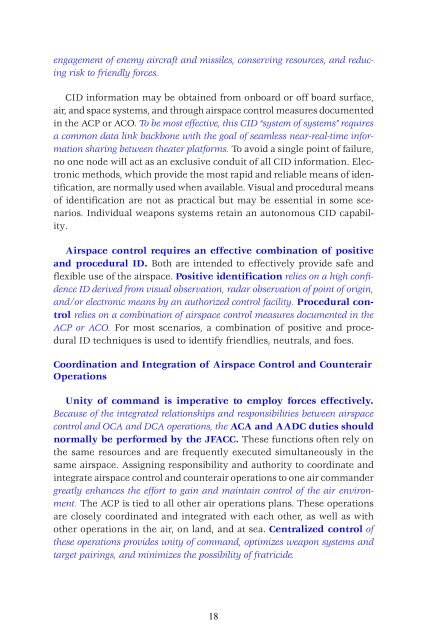Air Force Doctrine Document 2-1.1
Air Force Doctrine Document 2-1.1
Air Force Doctrine Document 2-1.1
Create successful ePaper yourself
Turn your PDF publications into a flip-book with our unique Google optimized e-Paper software.
engagement of enemy aircraft and missiles, conserving resources, and reducing<br />
risk to friendly forces.<br />
CID information may be obtained from onboard or off board surface,<br />
air, and space systems, and through airspace control measures documented<br />
in the ACP or ACO. To be most effective, this CID “system of systems” requires<br />
a common data link backbone with the goal of seamless near-real-time information<br />
sharing between theater platforms. To avoid a single point of failure,<br />
no one node will act as an exclusive conduit of all CID information. Electronic<br />
methods, which provide the most rapid and reliable means of identification,<br />
are normally used when available. Visual and procedural means<br />
of identification are not as practical but may be essential in some scenarios.<br />
Individual weapons systems retain an autonomous CID capability.<br />
<strong>Air</strong>space control requires an effective combination of positive<br />
and procedural ID. Both are intended to effectively provide safe and<br />
flexible use of the airspace. Positive identification relies on a high confidence<br />
ID derived from visual observation, radar observation of point of origin,<br />
and/or electronic means by an authorized control facility. Procedural control<br />
relies on a combination of airspace control measures documented in the<br />
ACP or ACO. For most scenarios, a combination of positive and procedural<br />
ID techniques is used to identify friendlies, neutrals, and foes.<br />
Coordination and Integration of <strong>Air</strong>space Control and Counterair<br />
Operations<br />
Unity of command is imperative to employ forces effectively.<br />
Because of the integrated relationships and responsibilities between airspace<br />
control and OCA and DCA operations, the ACA and AADC duties should<br />
normally be performed by the JFACC. These functions often rely on<br />
the same resources and are frequently executed simultaneously in the<br />
same airspace. Assigning responsibility and authority to coordinate and<br />
integrate airspace control and counterair operations to one air commander<br />
greatly enhances the effort to gain and maintain control of the air environment.<br />
The ACP is tied to all other air operations plans. These operations<br />
are closely coordinated and integrated with each other, as well as with<br />
other operations in the air, on land, and at sea. Centralized control of<br />
these operations provides unity of command, optimizes weapon systems and<br />
target pairings, and minimizes the possibility of fratricide.<br />
18
















